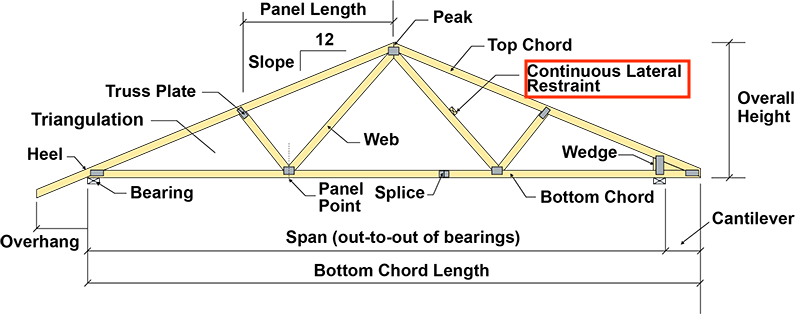By Olivier Biron, P.Eng.
Prefabricated light-frame wood roof trusses have been part of the construction world for over 50 years. For all their good qualities, typical installation issues with these structural elements are responsible for a significant proportion of roof collapses each winter. One of the most common causes of failure is a construction error, or more specifically, a misunderstanding of one of the most critical elements: the Continuous Lateral Bracing (CLB).
The typical roof truss is composed of sawn spruce, pine or fir members, usually in nominal sizes 2 x 3 to 2 x 8, forming the top, bottom and diagonal members. The quality of the wood (grade) used varies according to structural needs. Like any structural member, roof trusses must be designed according to the requirements of the applicable building code in the jurisdiction.
 Figure 1[1]: Elements that Make a Roof Truss.
Figure 1[1]: Elements that Make a Roof Truss.
What About the Continuous Lateral Bracing?
The web members, or diagonals (see Figure 1), can be loaded in either tension or compression. Tensioned members undergo little deformation when loaded. For compressed members, there is another factor in addition to the pure compressive strength: the slenderness of the member. The slenderness of a member is the ratio of its length to the smallest dimension of its cross-section (or weak axis). Excessive slenderness causes the compressed member to deflect long before the theoretical strength of the member is reached. This is called buckling. This phenomenon drastically reduces the capacity of the member, which then deforms further, causing a further reduction in its capacity. This vicious cycle can ultimately lead to the failure of the structure or to a permanent deformation of the compressed member.
To illustrate what buckling is, imagine a plastic ruler like the one you had in school. Place it upright, resting on a surface, and press down on the top of the ruler. It will deform (or buckle), without much effort, in its weak axis (thickness).
There is only one way to prevent buckling: reduce the slenderness factor. In the case of a roof truss, there are two options:
- Increase the web size. This requires the use of wider members throughout the truss, which is generally not practical as it increases the cost and weight of the truss.
- Reduce the effective length of the web members. This can be achieved by adding intermediate bracing to the member during construction. This is the most common and economical method. This brace consists of a piece of lumber attached to the webs in compression at locations specified by the truss designer / manufacturer. As you may have guessed, this is the CLB.
To illustrate the role of the CLB, take your ruler, pinch it halfway up and press it down again with your other hand while restricting its lateral movement. Not so easy, is it? So the CLB contributes significantly to the compressive strength of the member by dividing the effective length by half.
But that’s not all: the CLB prevents buckling by laterally linking together the web members of adjacent trusses. What happens if the compressed diagonals of all the trusses buckle in the same direction? The CLB is then of no use and buckling occurs almost freely.
 Figure 2: Compressed members bent in unison due to the absence of continuous lateral bracing
Figure 2: Compressed members bent in unison due to the absence of continuous lateral bracing
The importance of reading the instructions
In order to prevent lateral movement of the CLB, it is necessary to brace it with 45-degree pieces attached to the CLB and to the end of the compressed members of adjacent trusses. In general, light-frame truss manufacturers recommend a 20-foot spacing between these braces. This information should be shown on the structural drawings, if available, as well as on the roof truss shop drawings and installation instructions.
 Figure 3[2]: Bracing of CLBs
Figure 3[2]: Bracing of CLBs
It should be noted that at the top chords (Figure 1) of regular roof trusses, the metal roofing, or wood decking acts as a diaphragm, stabilizing the chords laterally.
In our experience, failure of light-frame wood trusses with no apparent signs of degradation occurs, most often, due to missing, improperly positioned, or continuous unbraced ties when they are under significant stress from snow, ice or wind loading. This is often an oversight or misunderstanding on the part of the installer. CEP Forensic’s structural and civil engineering experts can assist you with claims related to the failure of a light-frame roof structure, whether it was caused by a faulty CLB or by some other factor.
[1] Source: Structural Building Components Association (SBCA)
[2] Source: CECObois
